MKT550 - Global Marketing: Metcash Entering Indian Grocery Market
VerifiedAdded on 2020/11/02
|27
|8817
|110
Report
AI Summary
This report presents a comprehensive international marketing plan for Metcash's entry into the Indian grocery market. It begins with an executive summary and table of contents, followed by an introduction outlining the global economic landscape and the importance of international marketing. The report establishes marketing objectives, including gaining market share, increasing brand awareness, fostering customer engagement, and establishing a physical presence. A detailed business environment analysis assesses political, economic, social, technological, environmental, and legal factors. Market analysis focuses on the growing e-commerce sector in India, the target customer segment, and the market's growth potential. A competitor analysis identifies key players and their competitive advantages. The report then outlines Metcash's organizational assets and skills, conducts a SWOT analysis, and explores market entry options. The STP approach is discussed, and the 7Ps of the marketing mix (Product, Price, Place, Promotion, People, Process, and Physical Evidence) are thoroughly examined. Finally, the report addresses the management, measurement, and control of international marketing efforts, concluding with a summary of key findings and a list of references.
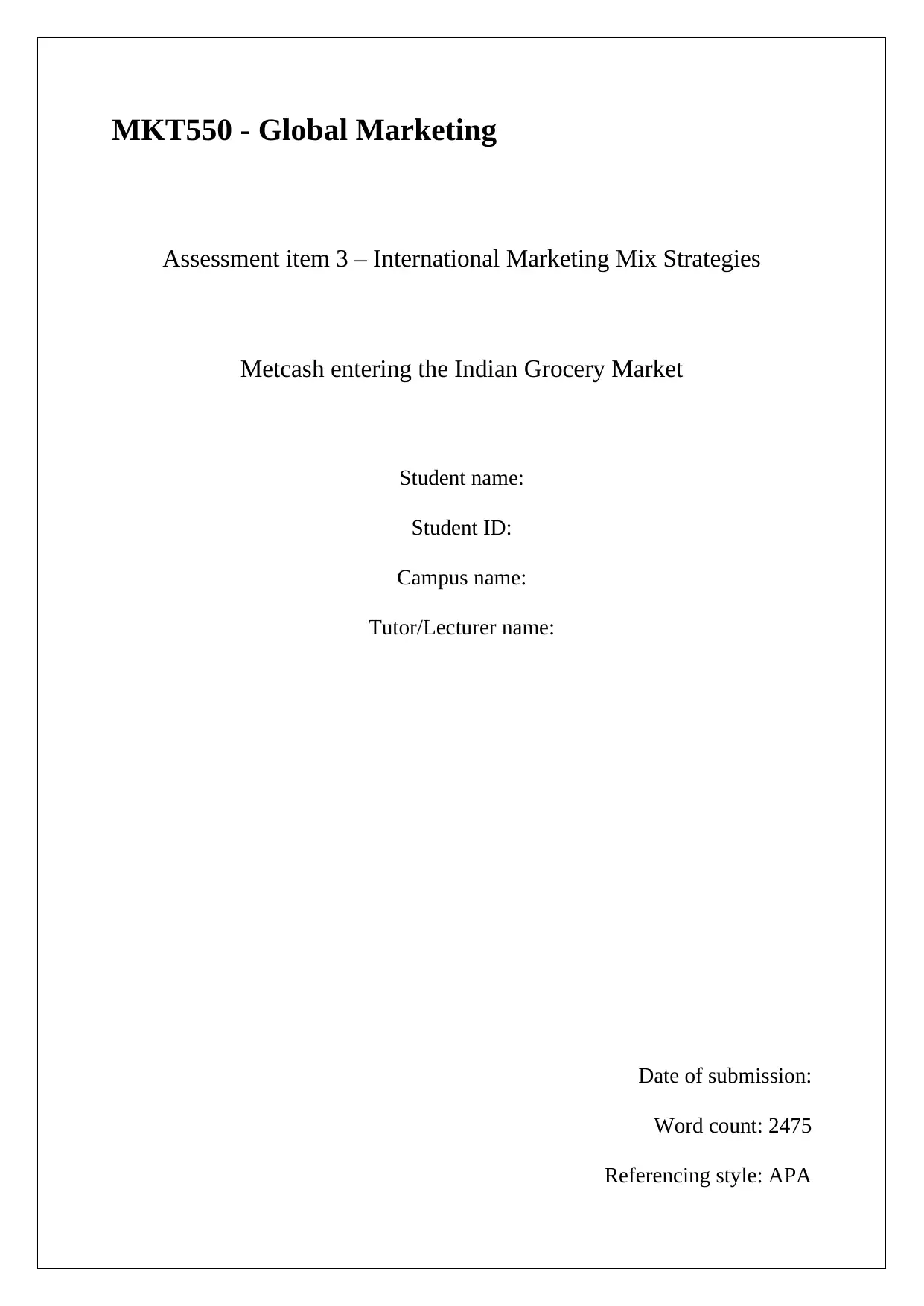
MKT550 - Global Marketing
Assessment item 3 – International Marketing Mix Strategies
Metcash entering the Indian Grocery Market
Student name:
Student ID:
Campus name:
Tutor/Lecturer name:
Date of submission:
Word count: 2475
Referencing style: APA
Assessment item 3 – International Marketing Mix Strategies
Metcash entering the Indian Grocery Market
Student name:
Student ID:
Campus name:
Tutor/Lecturer name:
Date of submission:
Word count: 2475
Referencing style: APA
Paraphrase This Document
Need a fresh take? Get an instant paraphrase of this document with our AI Paraphraser
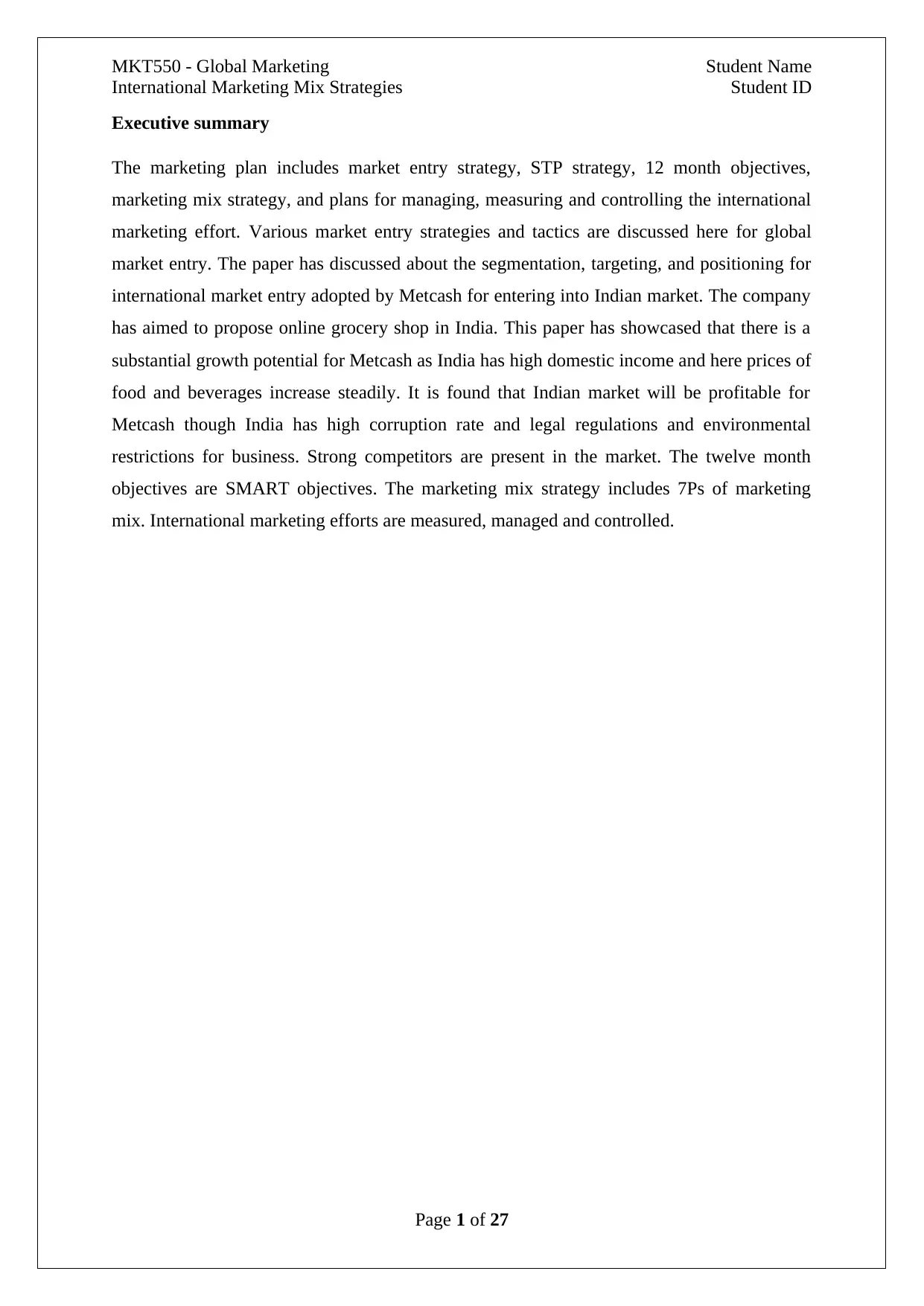
MKT550 - Global Marketing Student Name
International Marketing Mix Strategies Student ID
Executive summary
The marketing plan includes market entry strategy, STP strategy, 12 month objectives,
marketing mix strategy, and plans for managing, measuring and controlling the international
marketing effort. Various market entry strategies and tactics are discussed here for global
market entry. The paper has discussed about the segmentation, targeting, and positioning for
international market entry adopted by Metcash for entering into Indian market. The company
has aimed to propose online grocery shop in India. This paper has showcased that there is a
substantial growth potential for Metcash as India has high domestic income and here prices of
food and beverages increase steadily. It is found that Indian market will be profitable for
Metcash though India has high corruption rate and legal regulations and environmental
restrictions for business. Strong competitors are present in the market. The twelve month
objectives are SMART objectives. The marketing mix strategy includes 7Ps of marketing
mix. International marketing efforts are measured, managed and controlled.
Page 1 of 27
International Marketing Mix Strategies Student ID
Executive summary
The marketing plan includes market entry strategy, STP strategy, 12 month objectives,
marketing mix strategy, and plans for managing, measuring and controlling the international
marketing effort. Various market entry strategies and tactics are discussed here for global
market entry. The paper has discussed about the segmentation, targeting, and positioning for
international market entry adopted by Metcash for entering into Indian market. The company
has aimed to propose online grocery shop in India. This paper has showcased that there is a
substantial growth potential for Metcash as India has high domestic income and here prices of
food and beverages increase steadily. It is found that Indian market will be profitable for
Metcash though India has high corruption rate and legal regulations and environmental
restrictions for business. Strong competitors are present in the market. The twelve month
objectives are SMART objectives. The marketing mix strategy includes 7Ps of marketing
mix. International marketing efforts are measured, managed and controlled.
Page 1 of 27
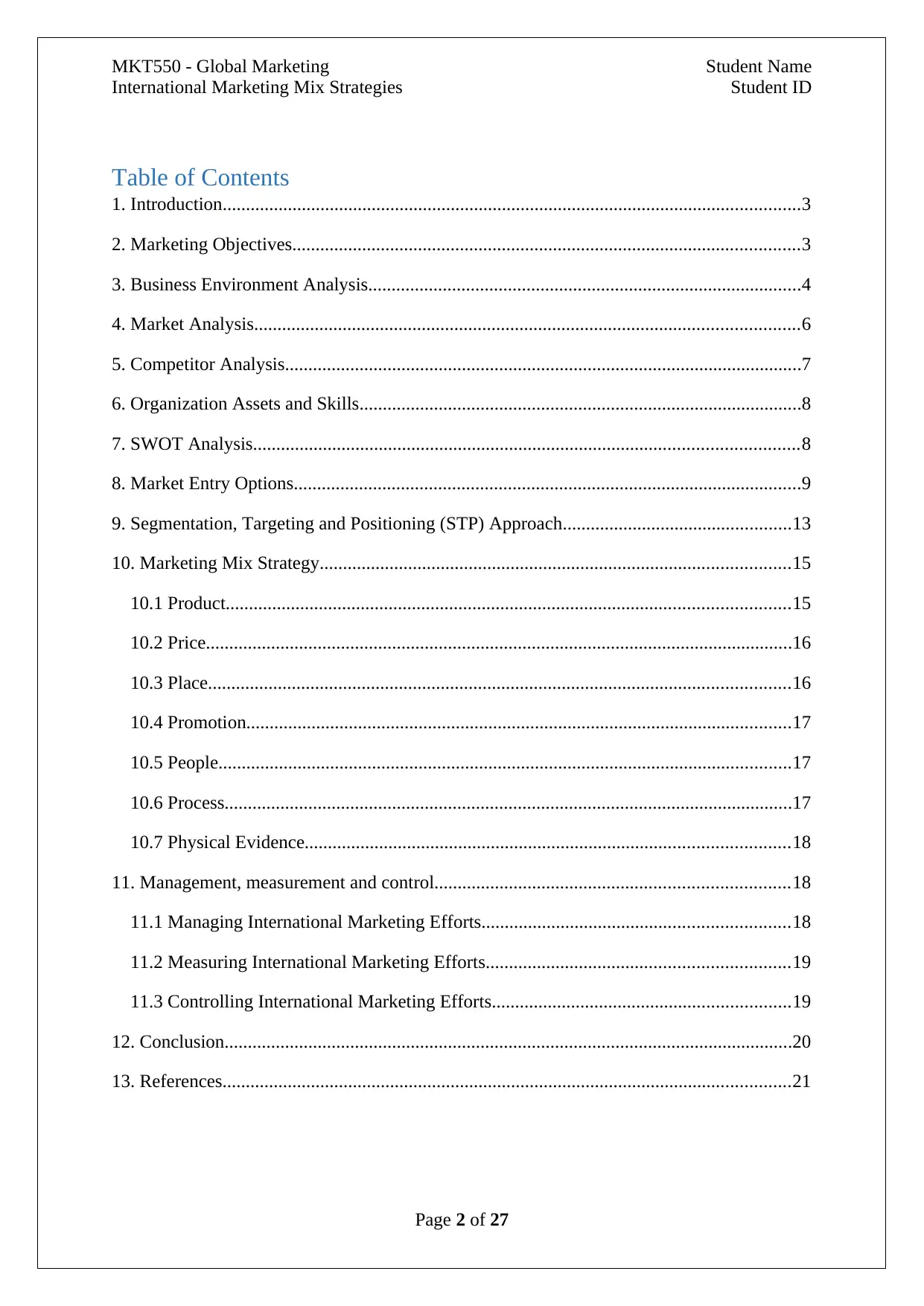
MKT550 - Global Marketing Student Name
International Marketing Mix Strategies Student ID
Table of Contents
1. Introduction............................................................................................................................3
2. Marketing Objectives.............................................................................................................3
3. Business Environment Analysis.............................................................................................4
4. Market Analysis.....................................................................................................................6
5. Competitor Analysis...............................................................................................................7
6. Organization Assets and Skills...............................................................................................8
7. SWOT Analysis.....................................................................................................................8
8. Market Entry Options.............................................................................................................9
9. Segmentation, Targeting and Positioning (STP) Approach.................................................13
10. Marketing Mix Strategy.....................................................................................................15
10.1 Product.........................................................................................................................15
10.2 Price..............................................................................................................................16
10.3 Place.............................................................................................................................16
10.4 Promotion.....................................................................................................................17
10.5 People...........................................................................................................................17
10.6 Process..........................................................................................................................17
10.7 Physical Evidence........................................................................................................18
11. Management, measurement and control............................................................................18
11.1 Managing International Marketing Efforts..................................................................18
11.2 Measuring International Marketing Efforts.................................................................19
11.3 Controlling International Marketing Efforts................................................................19
12. Conclusion..........................................................................................................................20
13. References..........................................................................................................................21
Page 2 of 27
International Marketing Mix Strategies Student ID
Table of Contents
1. Introduction............................................................................................................................3
2. Marketing Objectives.............................................................................................................3
3. Business Environment Analysis.............................................................................................4
4. Market Analysis.....................................................................................................................6
5. Competitor Analysis...............................................................................................................7
6. Organization Assets and Skills...............................................................................................8
7. SWOT Analysis.....................................................................................................................8
8. Market Entry Options.............................................................................................................9
9. Segmentation, Targeting and Positioning (STP) Approach.................................................13
10. Marketing Mix Strategy.....................................................................................................15
10.1 Product.........................................................................................................................15
10.2 Price..............................................................................................................................16
10.3 Place.............................................................................................................................16
10.4 Promotion.....................................................................................................................17
10.5 People...........................................................................................................................17
10.6 Process..........................................................................................................................17
10.7 Physical Evidence........................................................................................................18
11. Management, measurement and control............................................................................18
11.1 Managing International Marketing Efforts..................................................................18
11.2 Measuring International Marketing Efforts.................................................................19
11.3 Controlling International Marketing Efforts................................................................19
12. Conclusion..........................................................................................................................20
13. References..........................................................................................................................21
Page 2 of 27
⊘ This is a preview!⊘
Do you want full access?
Subscribe today to unlock all pages.

Trusted by 1+ million students worldwide
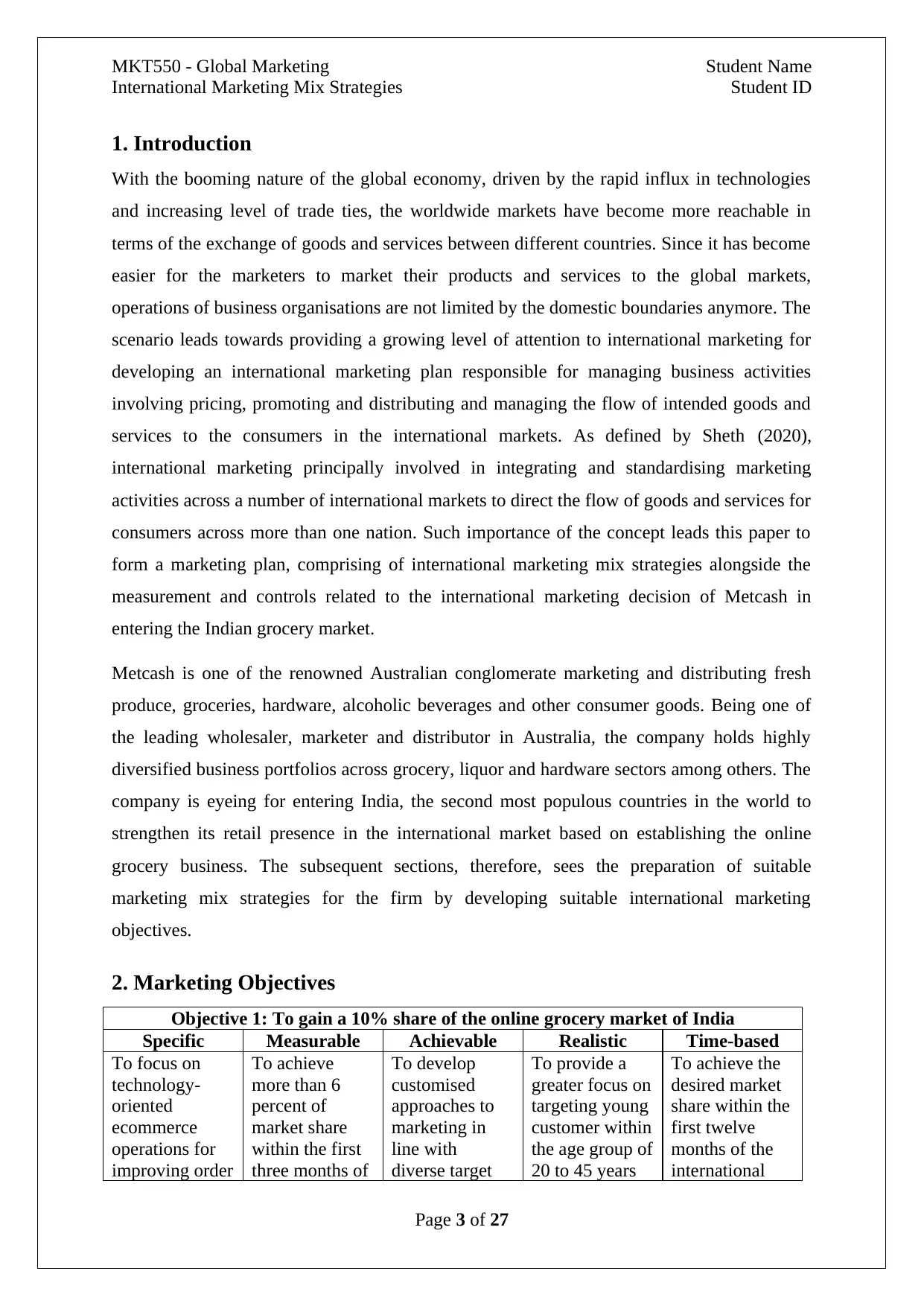
MKT550 - Global Marketing Student Name
International Marketing Mix Strategies Student ID
1. Introduction
With the booming nature of the global economy, driven by the rapid influx in technologies
and increasing level of trade ties, the worldwide markets have become more reachable in
terms of the exchange of goods and services between different countries. Since it has become
easier for the marketers to market their products and services to the global markets,
operations of business organisations are not limited by the domestic boundaries anymore. The
scenario leads towards providing a growing level of attention to international marketing for
developing an international marketing plan responsible for managing business activities
involving pricing, promoting and distributing and managing the flow of intended goods and
services to the consumers in the international markets. As defined by Sheth (2020),
international marketing principally involved in integrating and standardising marketing
activities across a number of international markets to direct the flow of goods and services for
consumers across more than one nation. Such importance of the concept leads this paper to
form a marketing plan, comprising of international marketing mix strategies alongside the
measurement and controls related to the international marketing decision of Metcash in
entering the Indian grocery market.
Metcash is one of the renowned Australian conglomerate marketing and distributing fresh
produce, groceries, hardware, alcoholic beverages and other consumer goods. Being one of
the leading wholesaler, marketer and distributor in Australia, the company holds highly
diversified business portfolios across grocery, liquor and hardware sectors among others. The
company is eyeing for entering India, the second most populous countries in the world to
strengthen its retail presence in the international market based on establishing the online
grocery business. The subsequent sections, therefore, sees the preparation of suitable
marketing mix strategies for the firm by developing suitable international marketing
objectives.
2. Marketing Objectives
Objective 1: To gain a 10% share of the online grocery market of India
Specific Measurable Achievable Realistic Time-based
To focus on
technology-
oriented
ecommerce
operations for
improving order
To achieve
more than 6
percent of
market share
within the first
three months of
To develop
customised
approaches to
marketing in
line with
diverse target
To provide a
greater focus on
targeting young
customer within
the age group of
20 to 45 years
To achieve the
desired market
share within the
first twelve
months of the
international
Page 3 of 27
International Marketing Mix Strategies Student ID
1. Introduction
With the booming nature of the global economy, driven by the rapid influx in technologies
and increasing level of trade ties, the worldwide markets have become more reachable in
terms of the exchange of goods and services between different countries. Since it has become
easier for the marketers to market their products and services to the global markets,
operations of business organisations are not limited by the domestic boundaries anymore. The
scenario leads towards providing a growing level of attention to international marketing for
developing an international marketing plan responsible for managing business activities
involving pricing, promoting and distributing and managing the flow of intended goods and
services to the consumers in the international markets. As defined by Sheth (2020),
international marketing principally involved in integrating and standardising marketing
activities across a number of international markets to direct the flow of goods and services for
consumers across more than one nation. Such importance of the concept leads this paper to
form a marketing plan, comprising of international marketing mix strategies alongside the
measurement and controls related to the international marketing decision of Metcash in
entering the Indian grocery market.
Metcash is one of the renowned Australian conglomerate marketing and distributing fresh
produce, groceries, hardware, alcoholic beverages and other consumer goods. Being one of
the leading wholesaler, marketer and distributor in Australia, the company holds highly
diversified business portfolios across grocery, liquor and hardware sectors among others. The
company is eyeing for entering India, the second most populous countries in the world to
strengthen its retail presence in the international market based on establishing the online
grocery business. The subsequent sections, therefore, sees the preparation of suitable
marketing mix strategies for the firm by developing suitable international marketing
objectives.
2. Marketing Objectives
Objective 1: To gain a 10% share of the online grocery market of India
Specific Measurable Achievable Realistic Time-based
To focus on
technology-
oriented
ecommerce
operations for
improving order
To achieve
more than 6
percent of
market share
within the first
three months of
To develop
customised
approaches to
marketing in
line with
diverse target
To provide a
greater focus on
targeting young
customer within
the age group of
20 to 45 years
To achieve the
desired market
share within the
first twelve
months of the
international
Page 3 of 27
Paraphrase This Document
Need a fresh take? Get an instant paraphrase of this document with our AI Paraphraser
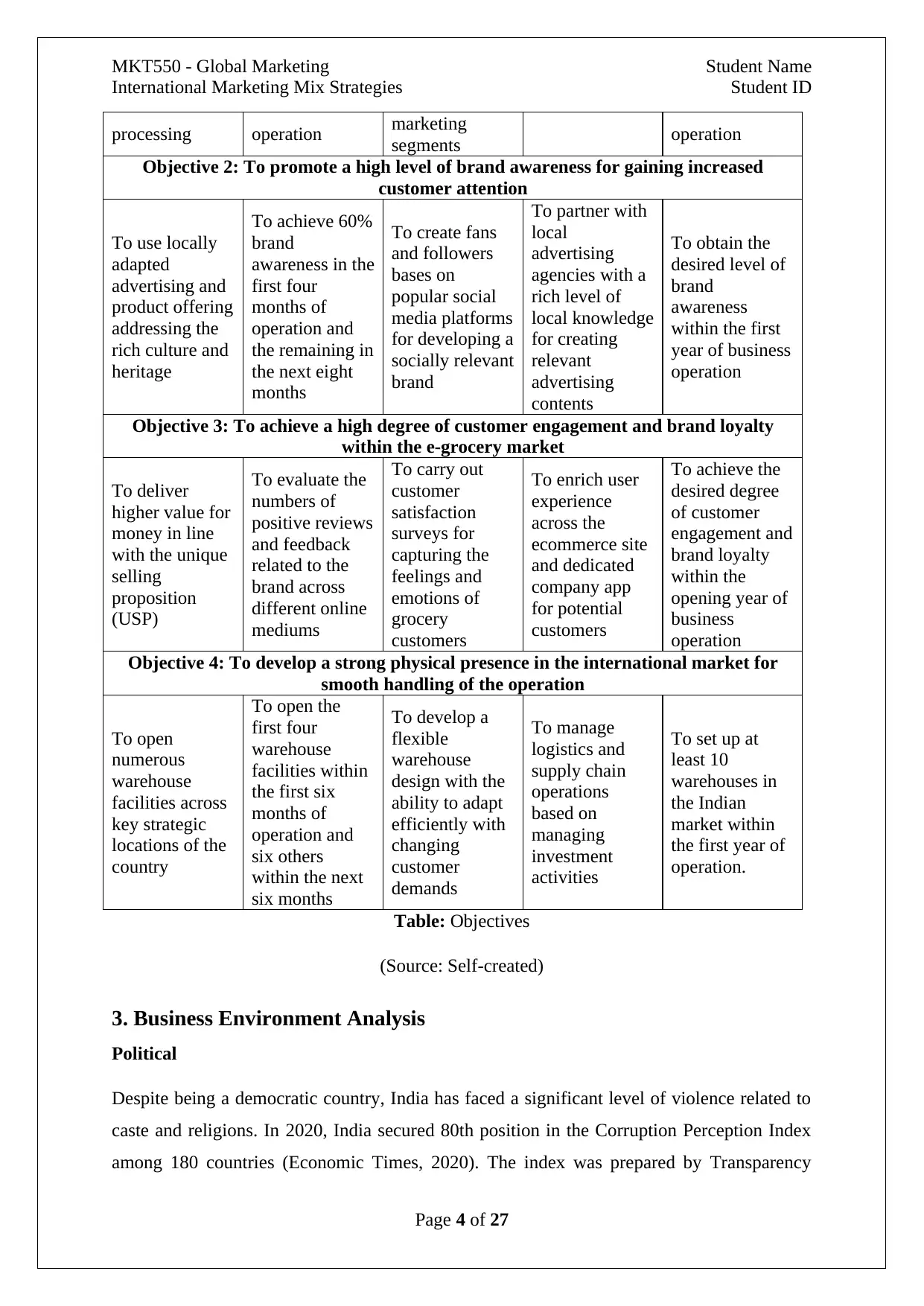
MKT550 - Global Marketing Student Name
International Marketing Mix Strategies Student ID
processing operation marketing
segments operation
Objective 2: To promote a high level of brand awareness for gaining increased
customer attention
To use locally
adapted
advertising and
product offering
addressing the
rich culture and
heritage
To achieve 60%
brand
awareness in the
first four
months of
operation and
the remaining in
the next eight
months
To create fans
and followers
bases on
popular social
media platforms
for developing a
socially relevant
brand
To partner with
local
advertising
agencies with a
rich level of
local knowledge
for creating
relevant
advertising
contents
To obtain the
desired level of
brand
awareness
within the first
year of business
operation
Objective 3: To achieve a high degree of customer engagement and brand loyalty
within the e-grocery market
To deliver
higher value for
money in line
with the unique
selling
proposition
(USP)
To evaluate the
numbers of
positive reviews
and feedback
related to the
brand across
different online
mediums
To carry out
customer
satisfaction
surveys for
capturing the
feelings and
emotions of
grocery
customers
To enrich user
experience
across the
ecommerce site
and dedicated
company app
for potential
customers
To achieve the
desired degree
of customer
engagement and
brand loyalty
within the
opening year of
business
operation
Objective 4: To develop a strong physical presence in the international market for
smooth handling of the operation
To open
numerous
warehouse
facilities across
key strategic
locations of the
country
To open the
first four
warehouse
facilities within
the first six
months of
operation and
six others
within the next
six months
To develop a
flexible
warehouse
design with the
ability to adapt
efficiently with
changing
customer
demands
To manage
logistics and
supply chain
operations
based on
managing
investment
activities
To set up at
least 10
warehouses in
the Indian
market within
the first year of
operation.
Table: Objectives
(Source: Self-created)
3. Business Environment Analysis
Political
Despite being a democratic country, India has faced a significant level of violence related to
caste and religions. In 2020, India secured 80th position in the Corruption Perception Index
among 180 countries (Economic Times, 2020). The index was prepared by Transparency
Page 4 of 27
International Marketing Mix Strategies Student ID
processing operation marketing
segments operation
Objective 2: To promote a high level of brand awareness for gaining increased
customer attention
To use locally
adapted
advertising and
product offering
addressing the
rich culture and
heritage
To achieve 60%
brand
awareness in the
first four
months of
operation and
the remaining in
the next eight
months
To create fans
and followers
bases on
popular social
media platforms
for developing a
socially relevant
brand
To partner with
local
advertising
agencies with a
rich level of
local knowledge
for creating
relevant
advertising
contents
To obtain the
desired level of
brand
awareness
within the first
year of business
operation
Objective 3: To achieve a high degree of customer engagement and brand loyalty
within the e-grocery market
To deliver
higher value for
money in line
with the unique
selling
proposition
(USP)
To evaluate the
numbers of
positive reviews
and feedback
related to the
brand across
different online
mediums
To carry out
customer
satisfaction
surveys for
capturing the
feelings and
emotions of
grocery
customers
To enrich user
experience
across the
ecommerce site
and dedicated
company app
for potential
customers
To achieve the
desired degree
of customer
engagement and
brand loyalty
within the
opening year of
business
operation
Objective 4: To develop a strong physical presence in the international market for
smooth handling of the operation
To open
numerous
warehouse
facilities across
key strategic
locations of the
country
To open the
first four
warehouse
facilities within
the first six
months of
operation and
six others
within the next
six months
To develop a
flexible
warehouse
design with the
ability to adapt
efficiently with
changing
customer
demands
To manage
logistics and
supply chain
operations
based on
managing
investment
activities
To set up at
least 10
warehouses in
the Indian
market within
the first year of
operation.
Table: Objectives
(Source: Self-created)
3. Business Environment Analysis
Political
Despite being a democratic country, India has faced a significant level of violence related to
caste and religions. In 2020, India secured 80th position in the Corruption Perception Index
among 180 countries (Economic Times, 2020). The index was prepared by Transparency
Page 4 of 27
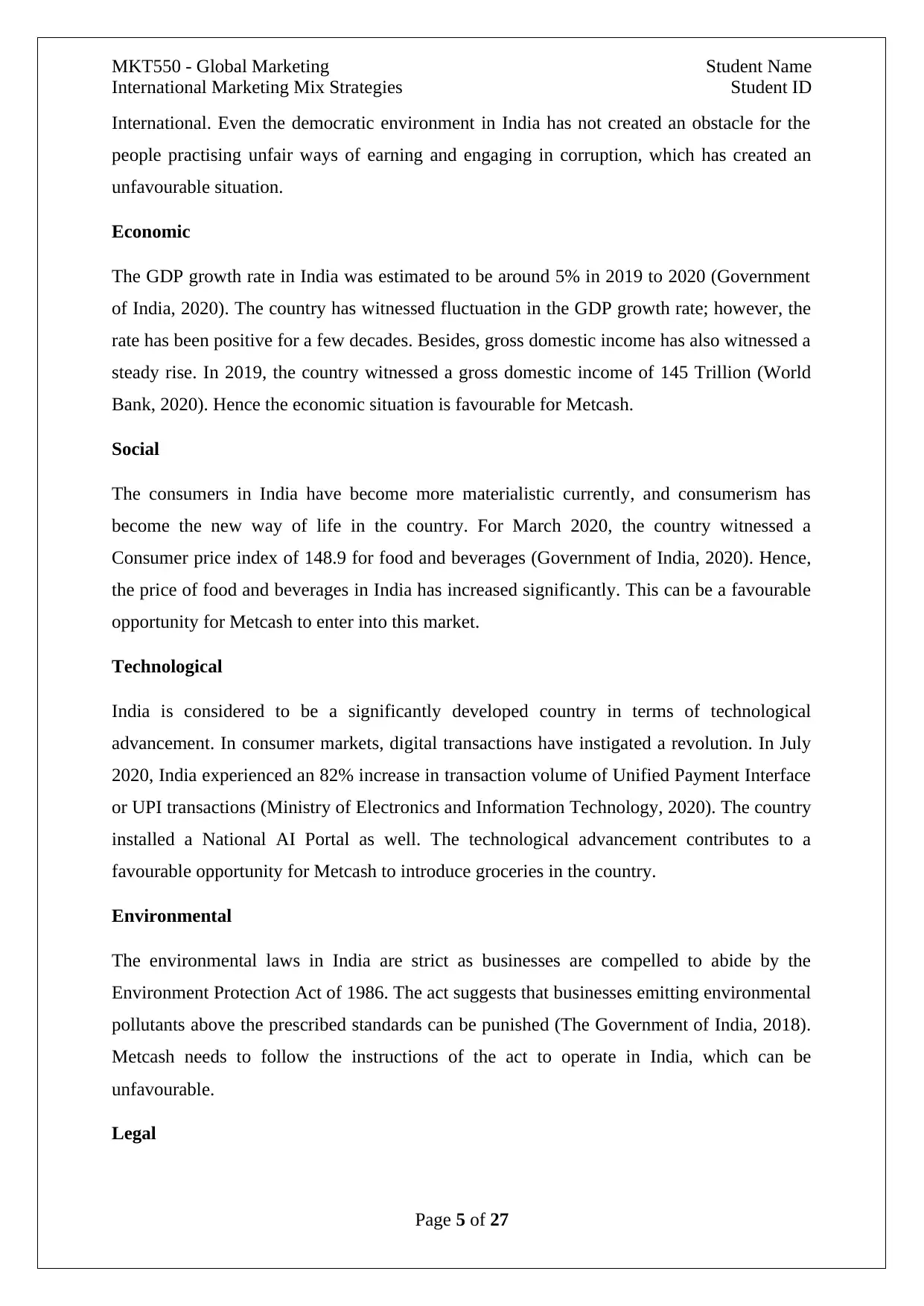
MKT550 - Global Marketing Student Name
International Marketing Mix Strategies Student ID
International. Even the democratic environment in India has not created an obstacle for the
people practising unfair ways of earning and engaging in corruption, which has created an
unfavourable situation.
Economic
The GDP growth rate in India was estimated to be around 5% in 2019 to 2020 (Government
of India, 2020). The country has witnessed fluctuation in the GDP growth rate; however, the
rate has been positive for a few decades. Besides, gross domestic income has also witnessed a
steady rise. In 2019, the country witnessed a gross domestic income of 145 Trillion (World
Bank, 2020). Hence the economic situation is favourable for Metcash.
Social
The consumers in India have become more materialistic currently, and consumerism has
become the new way of life in the country. For March 2020, the country witnessed a
Consumer price index of 148.9 for food and beverages (Government of India, 2020). Hence,
the price of food and beverages in India has increased significantly. This can be a favourable
opportunity for Metcash to enter into this market.
Technological
India is considered to be a significantly developed country in terms of technological
advancement. In consumer markets, digital transactions have instigated a revolution. In July
2020, India experienced an 82% increase in transaction volume of Unified Payment Interface
or UPI transactions (Ministry of Electronics and Information Technology, 2020). The country
installed a National AI Portal as well. The technological advancement contributes to a
favourable opportunity for Metcash to introduce groceries in the country.
Environmental
The environmental laws in India are strict as businesses are compelled to abide by the
Environment Protection Act of 1986. The act suggests that businesses emitting environmental
pollutants above the prescribed standards can be punished (The Government of India, 2018).
Metcash needs to follow the instructions of the act to operate in India, which can be
unfavourable.
Legal
Page 5 of 27
International Marketing Mix Strategies Student ID
International. Even the democratic environment in India has not created an obstacle for the
people practising unfair ways of earning and engaging in corruption, which has created an
unfavourable situation.
Economic
The GDP growth rate in India was estimated to be around 5% in 2019 to 2020 (Government
of India, 2020). The country has witnessed fluctuation in the GDP growth rate; however, the
rate has been positive for a few decades. Besides, gross domestic income has also witnessed a
steady rise. In 2019, the country witnessed a gross domestic income of 145 Trillion (World
Bank, 2020). Hence the economic situation is favourable for Metcash.
Social
The consumers in India have become more materialistic currently, and consumerism has
become the new way of life in the country. For March 2020, the country witnessed a
Consumer price index of 148.9 for food and beverages (Government of India, 2020). Hence,
the price of food and beverages in India has increased significantly. This can be a favourable
opportunity for Metcash to enter into this market.
Technological
India is considered to be a significantly developed country in terms of technological
advancement. In consumer markets, digital transactions have instigated a revolution. In July
2020, India experienced an 82% increase in transaction volume of Unified Payment Interface
or UPI transactions (Ministry of Electronics and Information Technology, 2020). The country
installed a National AI Portal as well. The technological advancement contributes to a
favourable opportunity for Metcash to introduce groceries in the country.
Environmental
The environmental laws in India are strict as businesses are compelled to abide by the
Environment Protection Act of 1986. The act suggests that businesses emitting environmental
pollutants above the prescribed standards can be punished (The Government of India, 2018).
Metcash needs to follow the instructions of the act to operate in India, which can be
unfavourable.
Legal
Page 5 of 27
⊘ This is a preview!⊘
Do you want full access?
Subscribe today to unlock all pages.

Trusted by 1+ million students worldwide
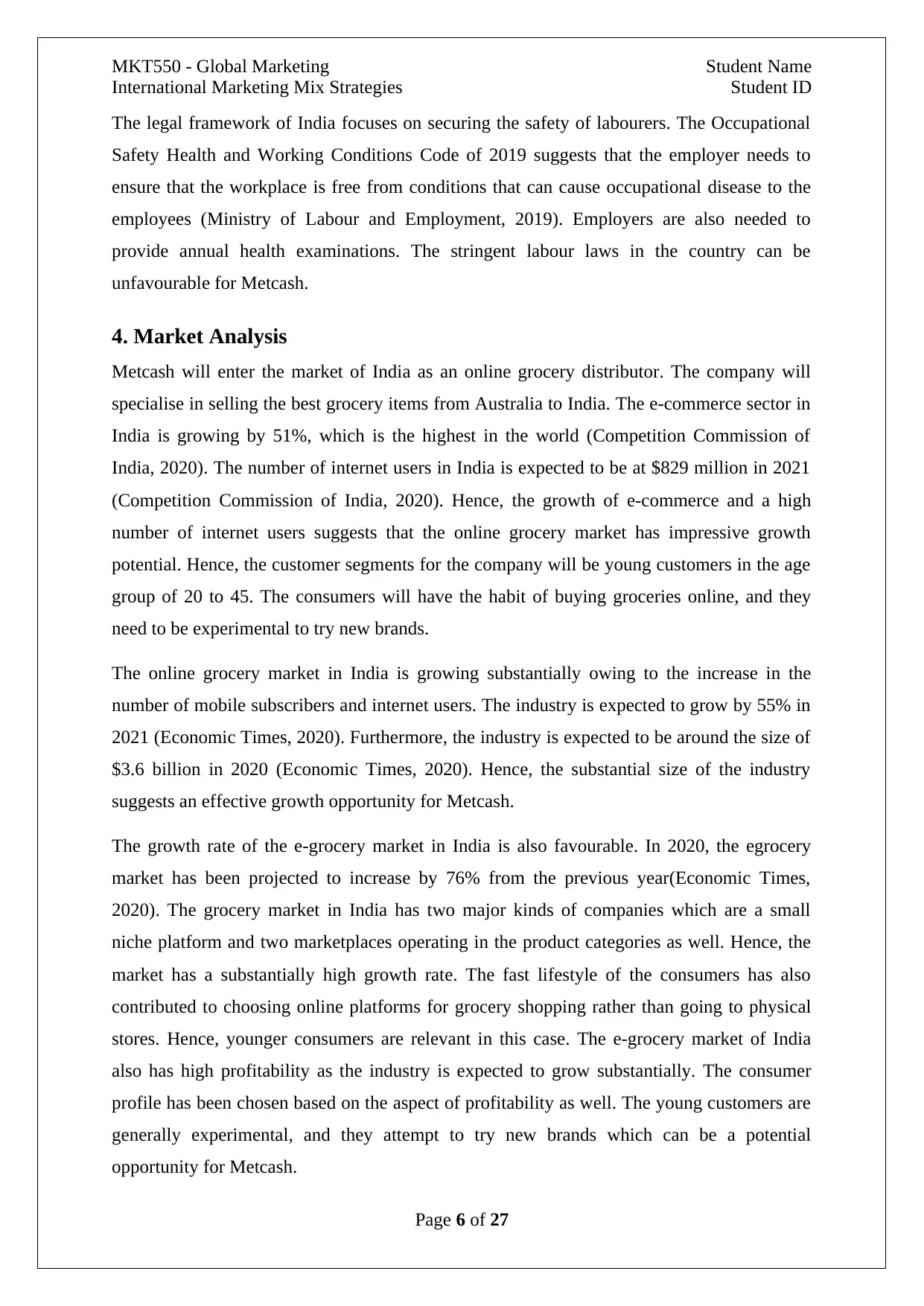
MKT550 - Global Marketing Student Name
International Marketing Mix Strategies Student ID
The legal framework of India focuses on securing the safety of labourers. The Occupational
Safety Health and Working Conditions Code of 2019 suggests that the employer needs to
ensure that the workplace is free from conditions that can cause occupational disease to the
employees (Ministry of Labour and Employment, 2019). Employers are also needed to
provide annual health examinations. The stringent labour laws in the country can be
unfavourable for Metcash.
4. Market Analysis
Metcash will enter the market of India as an online grocery distributor. The company will
specialise in selling the best grocery items from Australia to India. The e-commerce sector in
India is growing by 51%, which is the highest in the world (Competition Commission of
India, 2020). The number of internet users in India is expected to be at $829 million in 2021
(Competition Commission of India, 2020). Hence, the growth of e-commerce and a high
number of internet users suggests that the online grocery market has impressive growth
potential. Hence, the customer segments for the company will be young customers in the age
group of 20 to 45. The consumers will have the habit of buying groceries online, and they
need to be experimental to try new brands.
The online grocery market in India is growing substantially owing to the increase in the
number of mobile subscribers and internet users. The industry is expected to grow by 55% in
2021 (Economic Times, 2020). Furthermore, the industry is expected to be around the size of
$3.6 billion in 2020 (Economic Times, 2020). Hence, the substantial size of the industry
suggests an effective growth opportunity for Metcash.
The growth rate of the e-grocery market in India is also favourable. In 2020, the egrocery
market has been projected to increase by 76% from the previous year(Economic Times,
2020). The grocery market in India has two major kinds of companies which are a small
niche platform and two marketplaces operating in the product categories as well. Hence, the
market has a substantially high growth rate. The fast lifestyle of the consumers has also
contributed to choosing online platforms for grocery shopping rather than going to physical
stores. Hence, younger consumers are relevant in this case. The e-grocery market of India
also has high profitability as the industry is expected to grow substantially. The consumer
profile has been chosen based on the aspect of profitability as well. The young customers are
generally experimental, and they attempt to try new brands which can be a potential
opportunity for Metcash.
Page 6 of 27
International Marketing Mix Strategies Student ID
The legal framework of India focuses on securing the safety of labourers. The Occupational
Safety Health and Working Conditions Code of 2019 suggests that the employer needs to
ensure that the workplace is free from conditions that can cause occupational disease to the
employees (Ministry of Labour and Employment, 2019). Employers are also needed to
provide annual health examinations. The stringent labour laws in the country can be
unfavourable for Metcash.
4. Market Analysis
Metcash will enter the market of India as an online grocery distributor. The company will
specialise in selling the best grocery items from Australia to India. The e-commerce sector in
India is growing by 51%, which is the highest in the world (Competition Commission of
India, 2020). The number of internet users in India is expected to be at $829 million in 2021
(Competition Commission of India, 2020). Hence, the growth of e-commerce and a high
number of internet users suggests that the online grocery market has impressive growth
potential. Hence, the customer segments for the company will be young customers in the age
group of 20 to 45. The consumers will have the habit of buying groceries online, and they
need to be experimental to try new brands.
The online grocery market in India is growing substantially owing to the increase in the
number of mobile subscribers and internet users. The industry is expected to grow by 55% in
2021 (Economic Times, 2020). Furthermore, the industry is expected to be around the size of
$3.6 billion in 2020 (Economic Times, 2020). Hence, the substantial size of the industry
suggests an effective growth opportunity for Metcash.
The growth rate of the e-grocery market in India is also favourable. In 2020, the egrocery
market has been projected to increase by 76% from the previous year(Economic Times,
2020). The grocery market in India has two major kinds of companies which are a small
niche platform and two marketplaces operating in the product categories as well. Hence, the
market has a substantially high growth rate. The fast lifestyle of the consumers has also
contributed to choosing online platforms for grocery shopping rather than going to physical
stores. Hence, younger consumers are relevant in this case. The e-grocery market of India
also has high profitability as the industry is expected to grow substantially. The consumer
profile has been chosen based on the aspect of profitability as well. The young customers are
generally experimental, and they attempt to try new brands which can be a potential
opportunity for Metcash.
Page 6 of 27
Paraphrase This Document
Need a fresh take? Get an instant paraphrase of this document with our AI Paraphraser
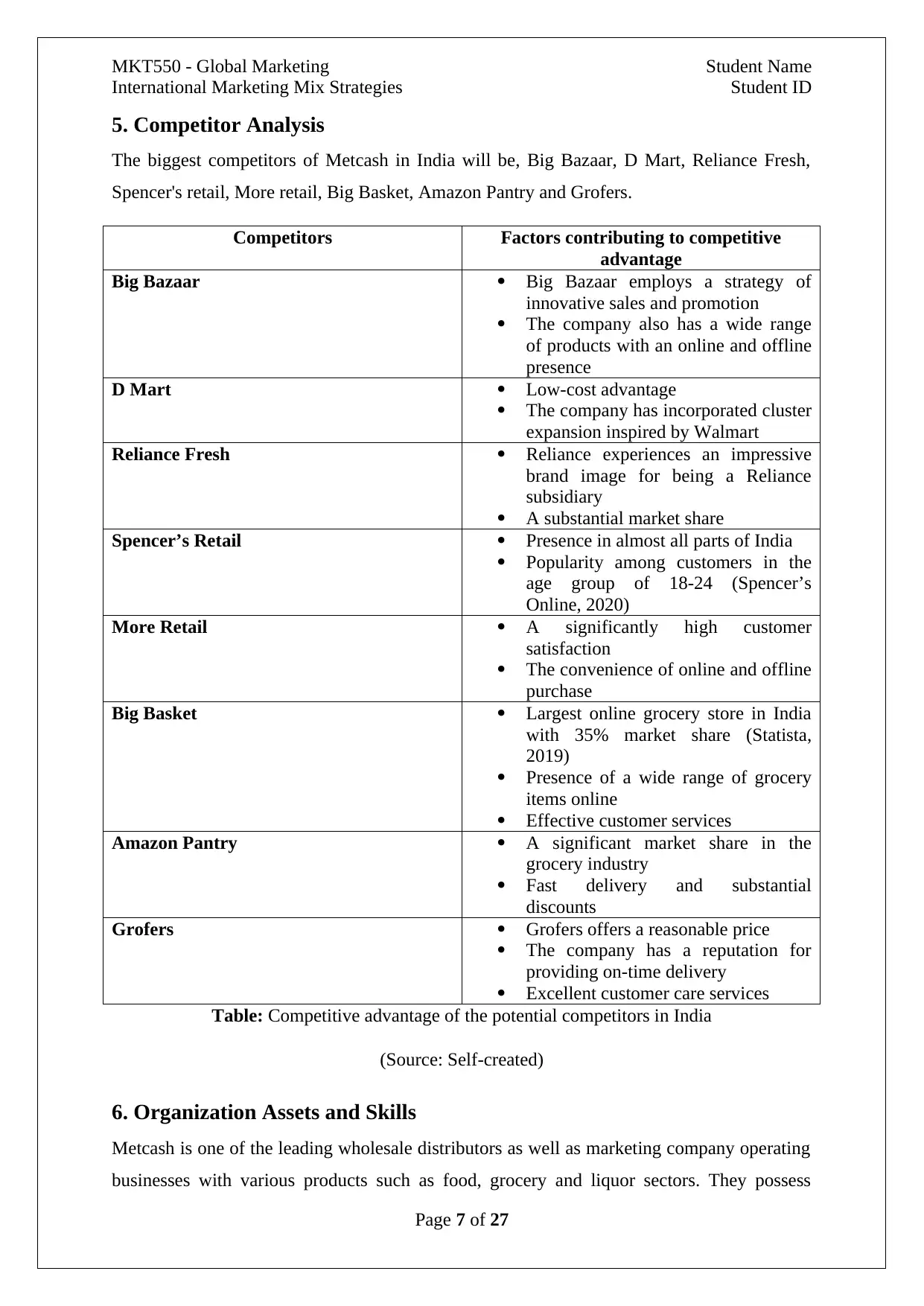
MKT550 - Global Marketing Student Name
International Marketing Mix Strategies Student ID
5. Competitor Analysis
The biggest competitors of Metcash in India will be, Big Bazaar, D Mart, Reliance Fresh,
Spencer's retail, More retail, Big Basket, Amazon Pantry and Grofers.
Competitors Factors contributing to competitive
advantage
Big Bazaar Big Bazaar employs a strategy of
innovative sales and promotion
The company also has a wide range
of products with an online and offline
presence
D Mart Low-cost advantage
The company has incorporated cluster
expansion inspired by Walmart
Reliance Fresh Reliance experiences an impressive
brand image for being a Reliance
subsidiary
A substantial market share
Spencer’s Retail Presence in almost all parts of India
Popularity among customers in the
age group of 18-24 (Spencer’s
Online, 2020)
More Retail A significantly high customer
satisfaction
The convenience of online and offline
purchase
Big Basket Largest online grocery store in India
with 35% market share (Statista,
2019)
Presence of a wide range of grocery
items online
Effective customer services
Amazon Pantry A significant market share in the
grocery industry
Fast delivery and substantial
discounts
Grofers Grofers offers a reasonable price
The company has a reputation for
providing on-time delivery
Excellent customer care services
Table: Competitive advantage of the potential competitors in India
(Source: Self-created)
6. Organization Assets and Skills
Metcash is one of the leading wholesale distributors as well as marketing company operating
businesses with various products such as food, grocery and liquor sectors. They possess
Page 7 of 27
International Marketing Mix Strategies Student ID
5. Competitor Analysis
The biggest competitors of Metcash in India will be, Big Bazaar, D Mart, Reliance Fresh,
Spencer's retail, More retail, Big Basket, Amazon Pantry and Grofers.
Competitors Factors contributing to competitive
advantage
Big Bazaar Big Bazaar employs a strategy of
innovative sales and promotion
The company also has a wide range
of products with an online and offline
presence
D Mart Low-cost advantage
The company has incorporated cluster
expansion inspired by Walmart
Reliance Fresh Reliance experiences an impressive
brand image for being a Reliance
subsidiary
A substantial market share
Spencer’s Retail Presence in almost all parts of India
Popularity among customers in the
age group of 18-24 (Spencer’s
Online, 2020)
More Retail A significantly high customer
satisfaction
The convenience of online and offline
purchase
Big Basket Largest online grocery store in India
with 35% market share (Statista,
2019)
Presence of a wide range of grocery
items online
Effective customer services
Amazon Pantry A significant market share in the
grocery industry
Fast delivery and substantial
discounts
Grofers Grofers offers a reasonable price
The company has a reputation for
providing on-time delivery
Excellent customer care services
Table: Competitive advantage of the potential competitors in India
(Source: Self-created)
6. Organization Assets and Skills
Metcash is one of the leading wholesale distributors as well as marketing company operating
businesses with various products such as food, grocery and liquor sectors. They possess
Page 7 of 27
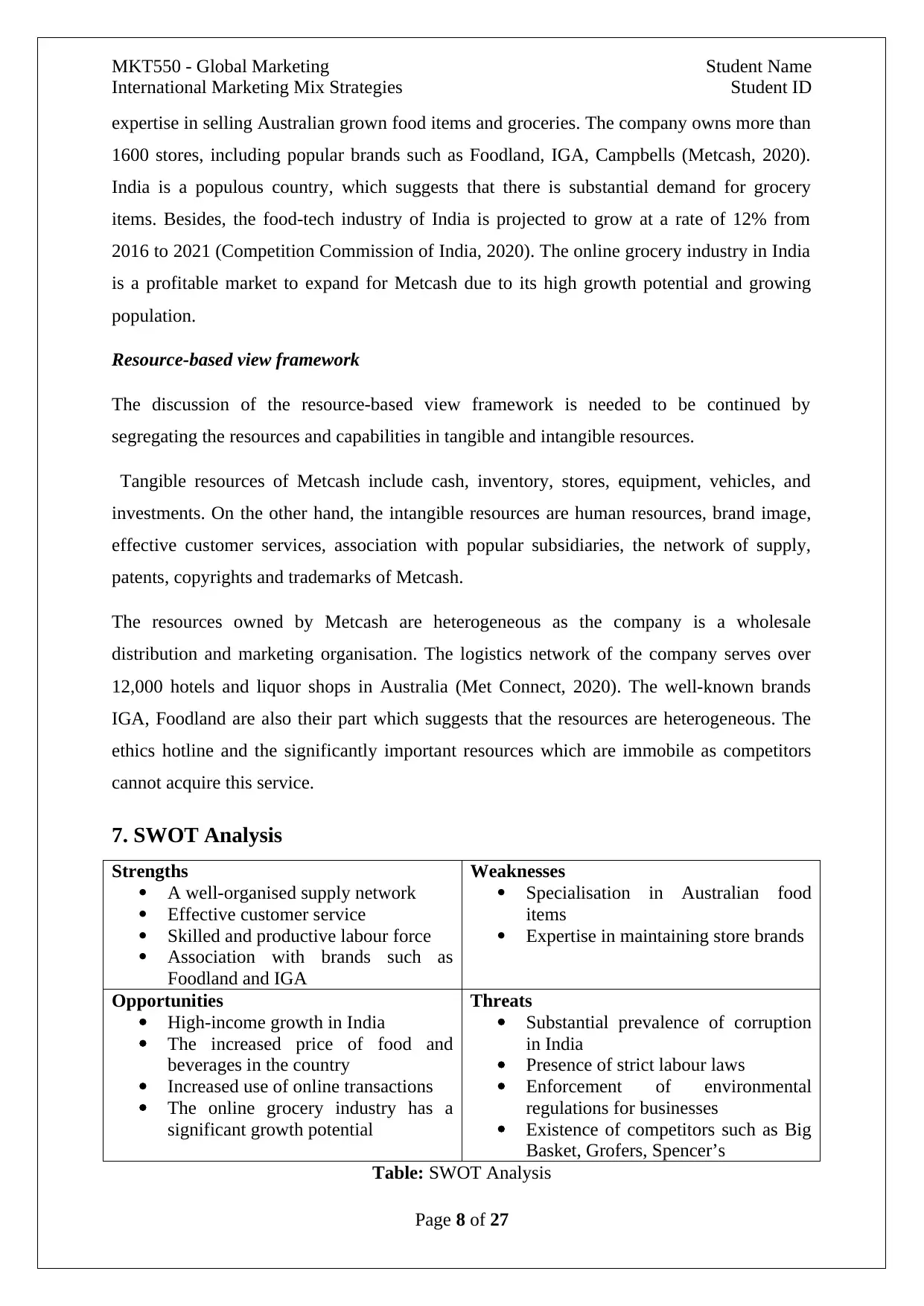
MKT550 - Global Marketing Student Name
International Marketing Mix Strategies Student ID
expertise in selling Australian grown food items and groceries. The company owns more than
1600 stores, including popular brands such as Foodland, IGA, Campbells (Metcash, 2020).
India is a populous country, which suggests that there is substantial demand for grocery
items. Besides, the food-tech industry of India is projected to grow at a rate of 12% from
2016 to 2021 (Competition Commission of India, 2020). The online grocery industry in India
is a profitable market to expand for Metcash due to its high growth potential and growing
population.
Resource-based view framework
The discussion of the resource-based view framework is needed to be continued by
segregating the resources and capabilities in tangible and intangible resources.
Tangible resources of Metcash include cash, inventory, stores, equipment, vehicles, and
investments. On the other hand, the intangible resources are human resources, brand image,
effective customer services, association with popular subsidiaries, the network of supply,
patents, copyrights and trademarks of Metcash.
The resources owned by Metcash are heterogeneous as the company is a wholesale
distribution and marketing organisation. The logistics network of the company serves over
12,000 hotels and liquor shops in Australia (Met Connect, 2020). The well-known brands
IGA, Foodland are also their part which suggests that the resources are heterogeneous. The
ethics hotline and the significantly important resources which are immobile as competitors
cannot acquire this service.
7. SWOT Analysis
Strengths
A well-organised supply network
Effective customer service
Skilled and productive labour force
Association with brands such as
Foodland and IGA
Weaknesses
Specialisation in Australian food
items
Expertise in maintaining store brands
Opportunities
High-income growth in India
The increased price of food and
beverages in the country
Increased use of online transactions
The online grocery industry has a
significant growth potential
Threats
Substantial prevalence of corruption
in India
Presence of strict labour laws
Enforcement of environmental
regulations for businesses
Existence of competitors such as Big
Basket, Grofers, Spencer’s
Table: SWOT Analysis
Page 8 of 27
International Marketing Mix Strategies Student ID
expertise in selling Australian grown food items and groceries. The company owns more than
1600 stores, including popular brands such as Foodland, IGA, Campbells (Metcash, 2020).
India is a populous country, which suggests that there is substantial demand for grocery
items. Besides, the food-tech industry of India is projected to grow at a rate of 12% from
2016 to 2021 (Competition Commission of India, 2020). The online grocery industry in India
is a profitable market to expand for Metcash due to its high growth potential and growing
population.
Resource-based view framework
The discussion of the resource-based view framework is needed to be continued by
segregating the resources and capabilities in tangible and intangible resources.
Tangible resources of Metcash include cash, inventory, stores, equipment, vehicles, and
investments. On the other hand, the intangible resources are human resources, brand image,
effective customer services, association with popular subsidiaries, the network of supply,
patents, copyrights and trademarks of Metcash.
The resources owned by Metcash are heterogeneous as the company is a wholesale
distribution and marketing organisation. The logistics network of the company serves over
12,000 hotels and liquor shops in Australia (Met Connect, 2020). The well-known brands
IGA, Foodland are also their part which suggests that the resources are heterogeneous. The
ethics hotline and the significantly important resources which are immobile as competitors
cannot acquire this service.
7. SWOT Analysis
Strengths
A well-organised supply network
Effective customer service
Skilled and productive labour force
Association with brands such as
Foodland and IGA
Weaknesses
Specialisation in Australian food
items
Expertise in maintaining store brands
Opportunities
High-income growth in India
The increased price of food and
beverages in the country
Increased use of online transactions
The online grocery industry has a
significant growth potential
Threats
Substantial prevalence of corruption
in India
Presence of strict labour laws
Enforcement of environmental
regulations for businesses
Existence of competitors such as Big
Basket, Grofers, Spencer’s
Table: SWOT Analysis
Page 8 of 27
⊘ This is a preview!⊘
Do you want full access?
Subscribe today to unlock all pages.

Trusted by 1+ million students worldwide
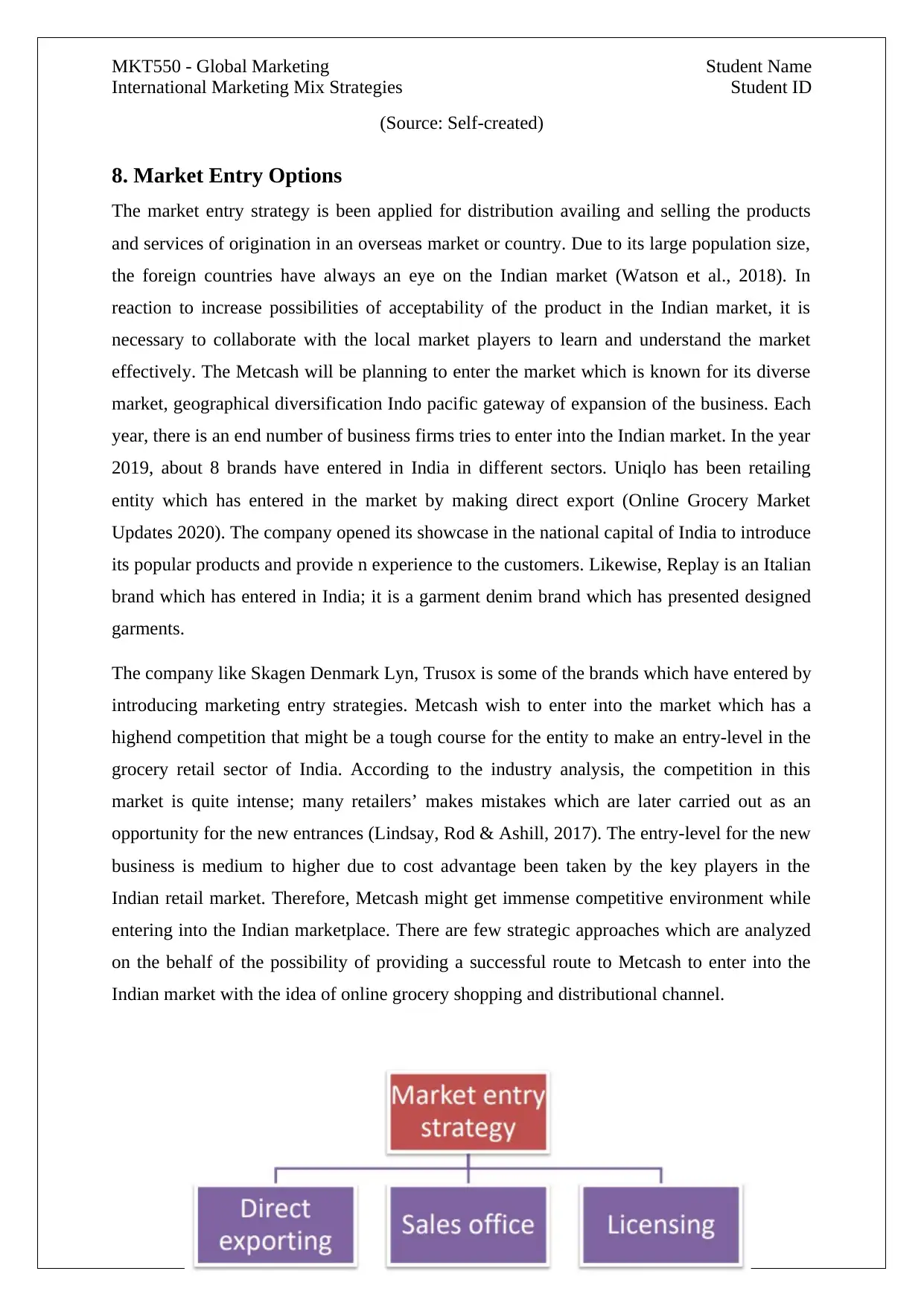
MKT550 - Global Marketing Student Name
International Marketing Mix Strategies Student ID
(Source: Self-created)
8. Market Entry Options
The market entry strategy is been applied for distribution availing and selling the products
and services of origination in an overseas market or country. Due to its large population size,
the foreign countries have always an eye on the Indian market (Watson et al., 2018). In
reaction to increase possibilities of acceptability of the product in the Indian market, it is
necessary to collaborate with the local market players to learn and understand the market
effectively. The Metcash will be planning to enter the market which is known for its diverse
market, geographical diversification Indo pacific gateway of expansion of the business. Each
year, there is an end number of business firms tries to enter into the Indian market. In the year
2019, about 8 brands have entered in India in different sectors. Uniqlo has been retailing
entity which has entered in the market by making direct export (Online Grocery Market
Updates 2020). The company opened its showcase in the national capital of India to introduce
its popular products and provide n experience to the customers. Likewise, Replay is an Italian
brand which has entered in India; it is a garment denim brand which has presented designed
garments.
The company like Skagen Denmark Lyn, Trusox is some of the brands which have entered by
introducing marketing entry strategies. Metcash wish to enter into the market which has a
highend competition that might be a tough course for the entity to make an entry-level in the
grocery retail sector of India. According to the industry analysis, the competition in this
market is quite intense; many retailers’ makes mistakes which are later carried out as an
opportunity for the new entrances (Lindsay, Rod & Ashill, 2017). The entry-level for the new
business is medium to higher due to cost advantage been taken by the key players in the
Indian retail market. Therefore, Metcash might get immense competitive environment while
entering into the Indian marketplace. There are few strategic approaches which are analyzed
on the behalf of the possibility of providing a successful route to Metcash to enter into the
Indian market with the idea of online grocery shopping and distributional channel.
Page 9 of 27
International Marketing Mix Strategies Student ID
(Source: Self-created)
8. Market Entry Options
The market entry strategy is been applied for distribution availing and selling the products
and services of origination in an overseas market or country. Due to its large population size,
the foreign countries have always an eye on the Indian market (Watson et al., 2018). In
reaction to increase possibilities of acceptability of the product in the Indian market, it is
necessary to collaborate with the local market players to learn and understand the market
effectively. The Metcash will be planning to enter the market which is known for its diverse
market, geographical diversification Indo pacific gateway of expansion of the business. Each
year, there is an end number of business firms tries to enter into the Indian market. In the year
2019, about 8 brands have entered in India in different sectors. Uniqlo has been retailing
entity which has entered in the market by making direct export (Online Grocery Market
Updates 2020). The company opened its showcase in the national capital of India to introduce
its popular products and provide n experience to the customers. Likewise, Replay is an Italian
brand which has entered in India; it is a garment denim brand which has presented designed
garments.
The company like Skagen Denmark Lyn, Trusox is some of the brands which have entered by
introducing marketing entry strategies. Metcash wish to enter into the market which has a
highend competition that might be a tough course for the entity to make an entry-level in the
grocery retail sector of India. According to the industry analysis, the competition in this
market is quite intense; many retailers’ makes mistakes which are later carried out as an
opportunity for the new entrances (Lindsay, Rod & Ashill, 2017). The entry-level for the new
business is medium to higher due to cost advantage been taken by the key players in the
Indian retail market. Therefore, Metcash might get immense competitive environment while
entering into the Indian marketplace. There are few strategic approaches which are analyzed
on the behalf of the possibility of providing a successful route to Metcash to enter into the
Indian market with the idea of online grocery shopping and distributional channel.
Page 9 of 27
Paraphrase This Document
Need a fresh take? Get an instant paraphrase of this document with our AI Paraphraser
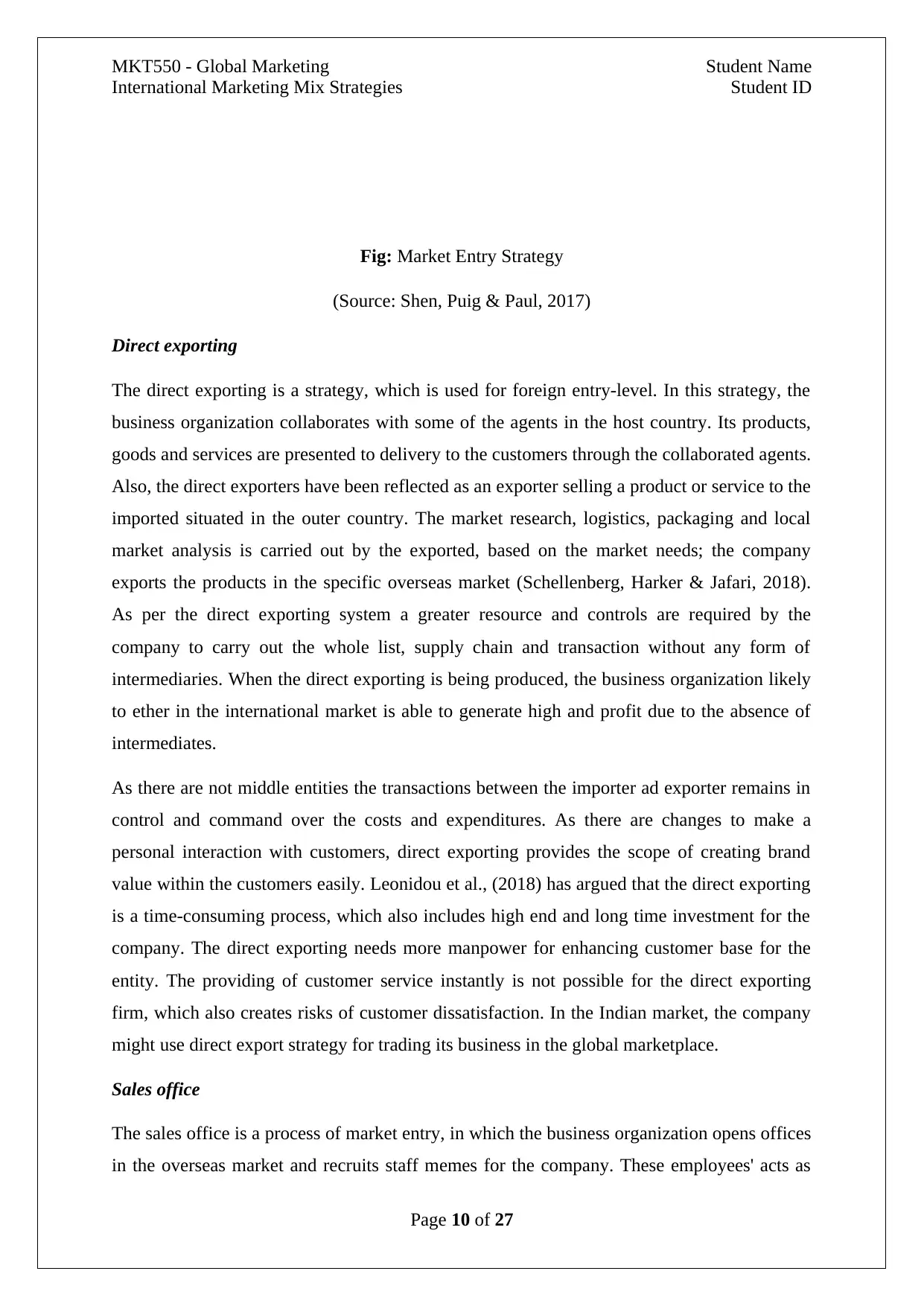
MKT550 - Global Marketing Student Name
International Marketing Mix Strategies Student ID
Fig: Market Entry Strategy
(Source: Shen, Puig & Paul, 2017)
Direct exporting
The direct exporting is a strategy, which is used for foreign entry-level. In this strategy, the
business organization collaborates with some of the agents in the host country. Its products,
goods and services are presented to delivery to the customers through the collaborated agents.
Also, the direct exporters have been reflected as an exporter selling a product or service to the
imported situated in the outer country. The market research, logistics, packaging and local
market analysis is carried out by the exported, based on the market needs; the company
exports the products in the specific overseas market (Schellenberg, Harker & Jafari, 2018).
As per the direct exporting system a greater resource and controls are required by the
company to carry out the whole list, supply chain and transaction without any form of
intermediaries. When the direct exporting is being produced, the business organization likely
to ether in the international market is able to generate high and profit due to the absence of
intermediates.
As there are not middle entities the transactions between the importer ad exporter remains in
control and command over the costs and expenditures. As there are changes to make a
personal interaction with customers, direct exporting provides the scope of creating brand
value within the customers easily. Leonidou et al., (2018) has argued that the direct exporting
is a time-consuming process, which also includes high end and long time investment for the
company. The direct exporting needs more manpower for enhancing customer base for the
entity. The providing of customer service instantly is not possible for the direct exporting
firm, which also creates risks of customer dissatisfaction. In the Indian market, the company
might use direct export strategy for trading its business in the global marketplace.
Sales office
The sales office is a process of market entry, in which the business organization opens offices
in the overseas market and recruits staff memes for the company. These employees' acts as
Page 10 of 27
International Marketing Mix Strategies Student ID
Fig: Market Entry Strategy
(Source: Shen, Puig & Paul, 2017)
Direct exporting
The direct exporting is a strategy, which is used for foreign entry-level. In this strategy, the
business organization collaborates with some of the agents in the host country. Its products,
goods and services are presented to delivery to the customers through the collaborated agents.
Also, the direct exporters have been reflected as an exporter selling a product or service to the
imported situated in the outer country. The market research, logistics, packaging and local
market analysis is carried out by the exported, based on the market needs; the company
exports the products in the specific overseas market (Schellenberg, Harker & Jafari, 2018).
As per the direct exporting system a greater resource and controls are required by the
company to carry out the whole list, supply chain and transaction without any form of
intermediaries. When the direct exporting is being produced, the business organization likely
to ether in the international market is able to generate high and profit due to the absence of
intermediates.
As there are not middle entities the transactions between the importer ad exporter remains in
control and command over the costs and expenditures. As there are changes to make a
personal interaction with customers, direct exporting provides the scope of creating brand
value within the customers easily. Leonidou et al., (2018) has argued that the direct exporting
is a time-consuming process, which also includes high end and long time investment for the
company. The direct exporting needs more manpower for enhancing customer base for the
entity. The providing of customer service instantly is not possible for the direct exporting
firm, which also creates risks of customer dissatisfaction. In the Indian market, the company
might use direct export strategy for trading its business in the global marketplace.
Sales office
The sales office is a process of market entry, in which the business organization opens offices
in the overseas market and recruits staff memes for the company. These employees' acts as
Page 10 of 27
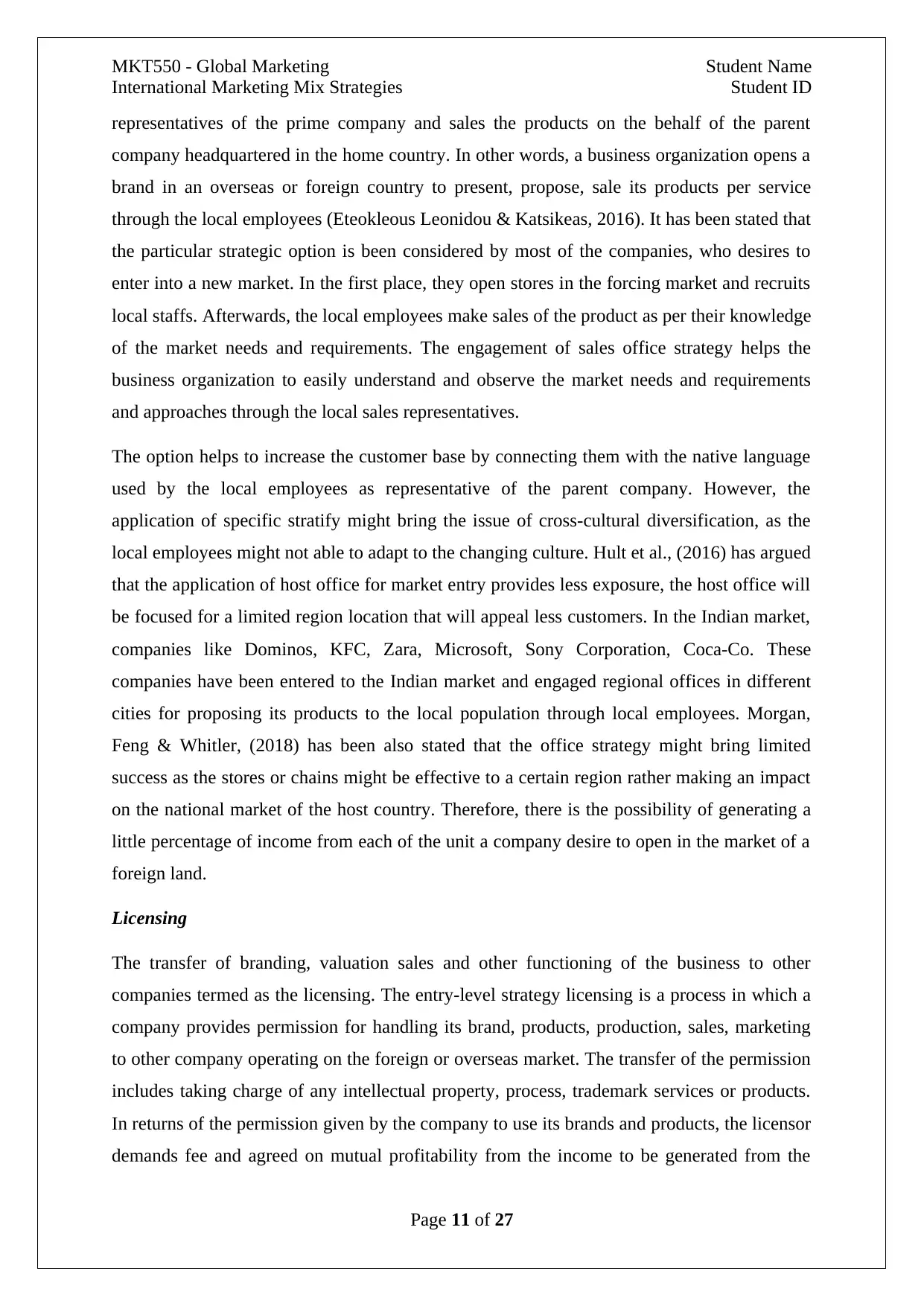
MKT550 - Global Marketing Student Name
International Marketing Mix Strategies Student ID
representatives of the prime company and sales the products on the behalf of the parent
company headquartered in the home country. In other words, a business organization opens a
brand in an overseas or foreign country to present, propose, sale its products per service
through the local employees (Eteokleous Leonidou & Katsikeas, 2016). It has been stated that
the particular strategic option is been considered by most of the companies, who desires to
enter into a new market. In the first place, they open stores in the forcing market and recruits
local staffs. Afterwards, the local employees make sales of the product as per their knowledge
of the market needs and requirements. The engagement of sales office strategy helps the
business organization to easily understand and observe the market needs and requirements
and approaches through the local sales representatives.
The option helps to increase the customer base by connecting them with the native language
used by the local employees as representative of the parent company. However, the
application of specific stratify might bring the issue of cross-cultural diversification, as the
local employees might not able to adapt to the changing culture. Hult et al., (2016) has argued
that the application of host office for market entry provides less exposure, the host office will
be focused for a limited region location that will appeal less customers. In the Indian market,
companies like Dominos, KFC, Zara, Microsoft, Sony Corporation, Coca-Co. These
companies have been entered to the Indian market and engaged regional offices in different
cities for proposing its products to the local population through local employees. Morgan,
Feng & Whitler, (2018) has been also stated that the office strategy might bring limited
success as the stores or chains might be effective to a certain region rather making an impact
on the national market of the host country. Therefore, there is the possibility of generating a
little percentage of income from each of the unit a company desire to open in the market of a
foreign land.
Licensing
The transfer of branding, valuation sales and other functioning of the business to other
companies termed as the licensing. The entry-level strategy licensing is a process in which a
company provides permission for handling its brand, products, production, sales, marketing
to other company operating on the foreign or overseas market. The transfer of the permission
includes taking charge of any intellectual property, process, trademark services or products.
In returns of the permission given by the company to use its brands and products, the licensor
demands fee and agreed on mutual profitability from the income to be generated from the
Page 11 of 27
International Marketing Mix Strategies Student ID
representatives of the prime company and sales the products on the behalf of the parent
company headquartered in the home country. In other words, a business organization opens a
brand in an overseas or foreign country to present, propose, sale its products per service
through the local employees (Eteokleous Leonidou & Katsikeas, 2016). It has been stated that
the particular strategic option is been considered by most of the companies, who desires to
enter into a new market. In the first place, they open stores in the forcing market and recruits
local staffs. Afterwards, the local employees make sales of the product as per their knowledge
of the market needs and requirements. The engagement of sales office strategy helps the
business organization to easily understand and observe the market needs and requirements
and approaches through the local sales representatives.
The option helps to increase the customer base by connecting them with the native language
used by the local employees as representative of the parent company. However, the
application of specific stratify might bring the issue of cross-cultural diversification, as the
local employees might not able to adapt to the changing culture. Hult et al., (2016) has argued
that the application of host office for market entry provides less exposure, the host office will
be focused for a limited region location that will appeal less customers. In the Indian market,
companies like Dominos, KFC, Zara, Microsoft, Sony Corporation, Coca-Co. These
companies have been entered to the Indian market and engaged regional offices in different
cities for proposing its products to the local population through local employees. Morgan,
Feng & Whitler, (2018) has been also stated that the office strategy might bring limited
success as the stores or chains might be effective to a certain region rather making an impact
on the national market of the host country. Therefore, there is the possibility of generating a
little percentage of income from each of the unit a company desire to open in the market of a
foreign land.
Licensing
The transfer of branding, valuation sales and other functioning of the business to other
companies termed as the licensing. The entry-level strategy licensing is a process in which a
company provides permission for handling its brand, products, production, sales, marketing
to other company operating on the foreign or overseas market. The transfer of the permission
includes taking charge of any intellectual property, process, trademark services or products.
In returns of the permission given by the company to use its brands and products, the licensor
demands fee and agreed on mutual profitability from the income to be generated from the
Page 11 of 27
⊘ This is a preview!⊘
Do you want full access?
Subscribe today to unlock all pages.

Trusted by 1+ million students worldwide
1 out of 27
Related Documents
Your All-in-One AI-Powered Toolkit for Academic Success.
+13062052269
info@desklib.com
Available 24*7 on WhatsApp / Email
![[object Object]](/_next/static/media/star-bottom.7253800d.svg)
Unlock your academic potential
Copyright © 2020–2025 A2Z Services. All Rights Reserved. Developed and managed by ZUCOL.





